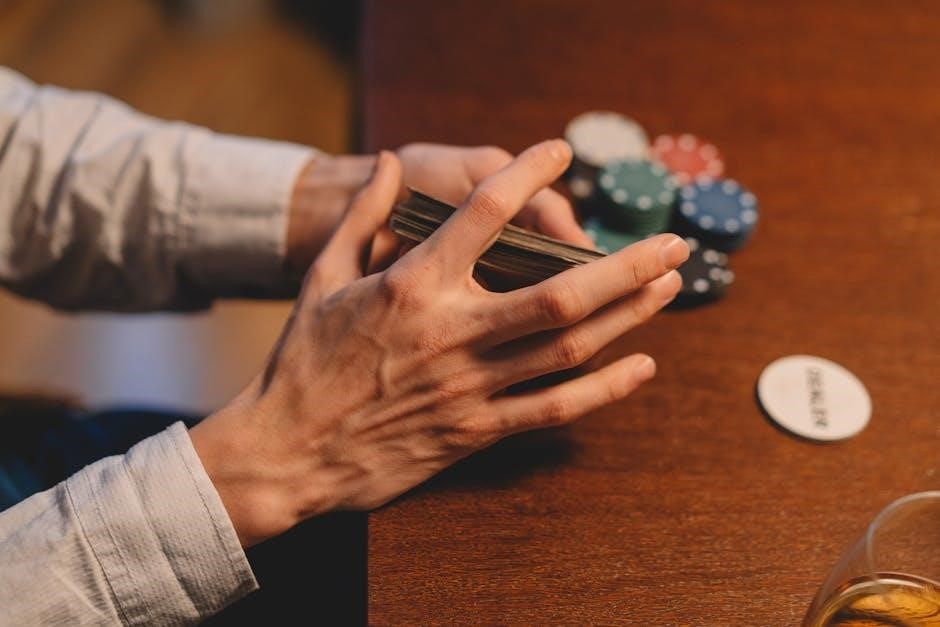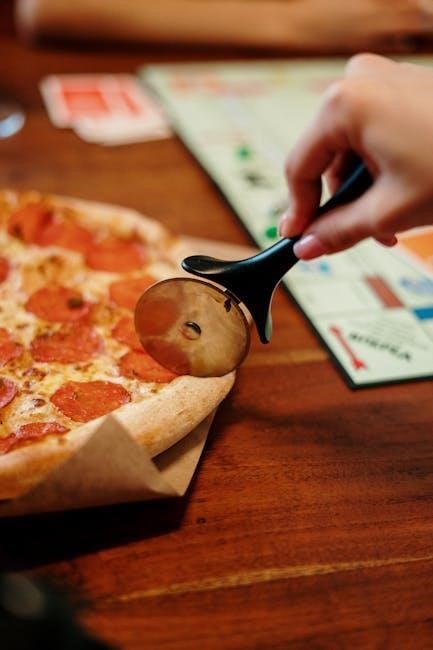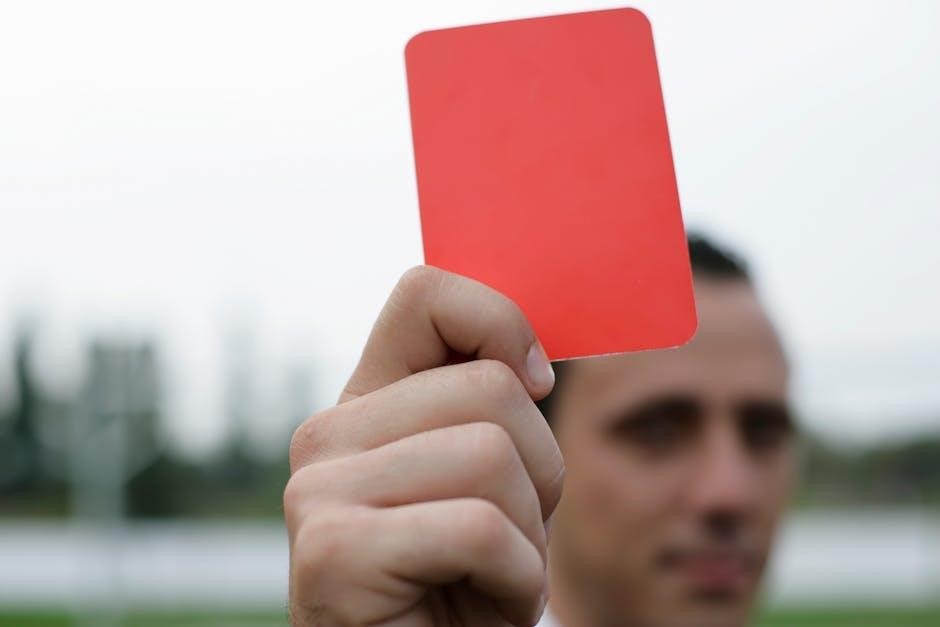Hand and Foot is a popular North American card game related to Canasta, involving two sets of cards: the Hand and the Foot. Using multiple decks with jokers, players aim to discard all cards first, starting with the Hand, then the Foot. Played in partnerships, it combines strategy and skill, making it a favorite among card game enthusiasts.
1.1 Overview of the Game
Hand and Foot is a rummy-style card game played with multiple decks, including jokers. It involves two sets of cards: the Hand and the Foot. Players aim to discard all cards by forming valid melds (sets or runs). The game is typically played in partnerships, with four or six players. Each player manages two piles: the Hand, played first, and the Foot, played after the Hand is exhausted. The objective is to be the first to rid of all cards, with scoring based on melded cards and penalties for unplayed ones. Strategy and efficient card management are key to success.
1.2 Brief History and Popularity
Hand and Foot emerged in North America in the mid-20th century, influenced by Canasta. It gained popularity for its unique two-pile system and strategic depth. The game is particularly favored in community centers and card clubs, offering a mix of complexity and social interaction. Its adaptability to different player numbers (4-6) adds to its appeal. The game’s enduring popularity stems from its engaging gameplay and the challenge of managing both the Hand and Foot effectively, making it a beloved choice for card enthusiasts seeking a dynamic and strategic experience.

Setup and Equipment
Hand and Foot requires 5-6 decks of cards, including jokers, depending on the number of players (4-6). Decks are shuffled together and evenly distributed.

2.1 Number of Players and Decks
Hand and Foot is typically played with 4 or 6 players, divided into partnerships. The game requires 5-6 decks of cards, including jokers, depending on the number of players. For 4 players, 5 decks are used, while 6 players require 6 decks. Each deck is combined and shuffled together to ensure randomness. Players sit in partnerships, with partners seated across from each other. The setup ensures equal distribution of cards, with each player dealing themselves two hands of 11 cards each, separating them into the Hand and Foot piles for gameplay.
2.2 Seating Arrangements
In Hand and Foot, players typically sit in partnerships, with partners seated directly across from each other. For 4 players, two partnerships are formed, while 6 players create three partnerships. The seating arrangement is usually clockwise, ensuring smooth gameplay and clear communication between teammates. The dealer, determined by drawing the highest card, starts the game, and play proceeds clockwise. This setup promotes teamwork and strategic coordination, essential for success in the game. Seating arrangements remain consistent throughout the game to maintain order and fairness.
2.3 Initial Dealing Process
In Hand and Foot, each round begins with dealing the cards. Players receive two hands: the Hand and the Foot. For 4 players, two decks are used, while 6 players require three decks. The dealer, determined by drawing the highest card, distributes the cards clockwise. Each player receives 15 cards for the Hand, 13 for the Knee, and 11 for the Foot. The dealer ensures all players have their respective stacks, with the remaining cards placed face down as a draw pile. This structured dealing process ensures fairness and prepares players for the melding phase.

Dealing the Cards
Hand and Foot uses multiple decks, with one deck per player. All decks are shuffled together. The dealer, chosen by high card draw, distributes cards. Each player receives two hands: the Hand and the Foot, with 15 and 11 cards respectively.
3.1 Distributing the Hand and Foot
The game begins by distributing the cards into two distinct sets for each player: the Hand and the Foot. Each player receives two hands of 11 cards. The Hand is used first, and the Foot is played only after the Hand is exhausted. The dealer, determined by a high card draw, distributes the cards, ensuring each player receives their respective sets. The process involves meticulous organization to maintain the integrity of the game structure, ensuring all players have equal opportunities to strategize and play effectively.
3.2 Determining the Dealer
To determine the dealer, each player draws a card from the shuffled deck. The player with the highest card becomes the dealer of the Hand, responsible for distributing 15 cards. The next highest card determines the dealer of the Knee, who distributes 13 cards, and the third highest card identifies the dealer of the Foot, distributing 11 cards. This hierarchical process ensures a fair and structured start to the game, with each dealer handling a specific set of cards based on their draw rank. The process repeats for each round, maintaining rotational fairness among players.

Gameplay Mechanics
Hand and Foot involves multiple rounds where players draw cards, meld sets or sequences, and strategically use jokers as wild cards to complete combinations and discard all cards.
4.1 Structure of Rounds
Hand and Foot is played over four rounds, with each round beginning with the dealing of cards into the Hand, Knee, and Foot piles. Players take turns drawing two cards and discarding one, aiming to meld cards into valid combinations. The round concludes when a player successfully melds all their cards, ending the round and transitioning to scoring. This structure emphasizes strategic planning and efficient card management, as players must balance building melds with reducing their card holdings.
4.2 Objectives and Winning Conditions

The primary objective in Hand and Foot is to be the first player or team to completely discard all cards by forming valid melds. Players must first empty their Hand before accessing the Foot. A player can go out by melding all remaining cards, earning a bonus. Winning conditions also include accumulating the highest score over multiple rounds, typically reaching a target like 10,000 points. Points are earned through melding and penalties for unplayed cards, making both efficiency and strategy crucial for victory.
4.3 Melding and Valid Combinations
In Hand and Foot, a valid meld consists of at least three cards of the same rank (a set) or three or more sequential cards of the same suit (a run). Jokers and wild cards can substitute for missing cards in a meld. A player can lay down multiple melds in a single turn, but each meld must meet the minimum requirement of three cards. All cards in a meld must be either natural or wild, not a mix of both. Players can also add to existing melds on the table, enhancing their strategy and scoring potential.
4.4 Special Role of Jokers and Wild Cards
Jokers and wild cards play a crucial role in Hand and Foot, acting as substitutes for missing cards in melds. They can be used to complete sets, runs, or extend existing combinations. However, their use is regulated: a meld cannot contain more wild cards than natural cards. Jokers are particularly valuable, as they can represent any card. Wild cards are essential for forming complex melds and can significantly enhance a player’s strategy. Proper use of these cards can make the difference between winning and losing, adding depth to the game’s dynamics;

Scoring and Point System
Hand and Foot uses a point system where each card has a specific value. Melding cards earns points, while unplayed cards at the end deduct points. Bonus points are awarded for special achievements, such as going out first, adding an extra layer of strategy to the game.
5.1 Points for Melding Cards
In Hand and Foot, each card has a specific point value when melded. Jokers and Aces are worth 20 points each, face cards (Kings, Queens, Jacks) are worth 10 points, and numbered cards are worth their face value. Wild cards, such as Jokers, can only be used once per meld. A valid meld requires at least three cards of the same rank or a sequence of three or more cards in the same suit. The points for melded cards are tallied at the end of each round, contributing to the team’s total score. Strategic melding is key to maximizing points.
5.2 Penalties for Unplayed Cards
Players incur penalties for any unplayed cards left in their hand or foot at the end of the game. Each card’s penalty points are deducted from the team’s score. Jokers and wild cards carry higher penalties, typically 20 points each, while face cards (Kings, Queens, Jacks) are penalized 10 points. Numbered cards are deducted at their face value. Aces, also worth 20 points, add to the penalty if unplayed. The goal is to minimize penalties by efficiently using all cards in melds or discarding strategically. This system encourages players to plan and manage their cards wisely throughout the game.
5.3 Bonus Points and Special Scoring
Bonus points are awarded for exceptional achievements in Hand and Foot. A player who successfully “goes out” by discarding all their cards earns a 100-point bonus. Special melds, such as natural hands or feet (without jokers or wild cards), grant additional points: 200 points for a natural hand and 300 points for a natural foot. Teams also receive 50 points for forming a red or black Canasta. These bonuses incentivize strategic play and add excitement to the game. They are added to the team’s score at the end of the round, enhancing their chances of winning.
Strategies and Tips
Mastering Hand and Foot requires strategic card management. Always prioritize melding high-value cards and use jokers wisely to complete combinations. Keep high cards for laying off and low cards for starting new melds. Effective communication with your partner is crucial to avoid penalties and maximize scoring opportunities. Balancing between playing from your hand and foot while maintaining flexibility ensures a competitive edge in the game.
6.1 Managing Hand and Foot Effectively
Effectively managing both your Hand and Foot is crucial for success. Start by organizing your cards into potential melds, keeping high-value cards for laying off and low cards for new combinations. Use jokers strategically to complete sets or runs, but avoid wasting them on unnecessary plays. Prioritize playing from your Hand first, as it must be emptied before accessing the Foot. Keep track of discarded cards to avoid picking up penalties. Plan your plays in a way that allows a smooth transition between the Hand and Foot, ensuring you maintain flexibility to adapt to the game’s flow and maximize your scoring potential.
6.2 Effective Use of Jokers
Jokers are wild cards that can significantly impact gameplay. Use them strategically to complete melds or extend existing ones, especially when natural cards are scarce. Avoid wasting jokers on small melds; save them for critical plays, such as finishing a round or completing a high-value combination. Jokers can also help bridge gaps between sets or runs, allowing you to maintain momentum. However, be cautious not to over-rely on them, as their misuse can lead to missed opportunities. Always consider the game’s flow and your opponents’ moves when deciding how to deploy your jokers effectively.
Hand and Foot combines skill and strategy, requiring players to manage two sets of cards effectively. Mastery lies in melding, timing, and wise use of jokers to secure victory.
7.1 Summary of Key Rules
Hand and Foot is a strategic card game played with multiple decks and jokers. Players aim to discard all cards by forming valid melds. The game involves two sets of cards: the Hand and the Foot. Jokers and wild cards add flexibility, while penalties apply for unplayed cards. Partnerships are common, and scoring is based on card values. The objective is to empty both hands efficiently, with bonus points for special combinations. Mastery requires balancing strategy, timing, and teamwork to achieve victory.
7.2 Final Tips for Beginners
New players should start by focusing on understanding the basics of melding and the importance of managing both the Hand and Foot. Practice organizing cards by rank and suit to spot potential combinations quickly. Communication with your partner is key, especially when using jokers or wild cards strategically. Avoid holding onto unplayable cards to minimize penalties. Learn when to transition to the Foot smoothly by ensuring all Hand cards are played. Start with simpler strategies and gradually incorporate more advanced techniques as you gain experience.
